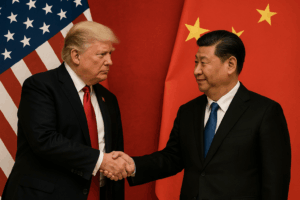BUSAN, South Korea – In a landmark gathering on Thursday at Gimhae Air Base in Busan, South Korea, U.S. President Donald Trump and Chinese President Xi Jinping announced a sweeping, if provisional, agreement intended to de-escalate the fraught economic relationship between the world’s two largest powers. The meeting — the first direct tĂŞte-Ă -tĂŞte between the two leaders since 2019 — culminated a five-day U.S. tour of Asia by President Trump and was heralded by both men in unusually upbeat terms.
President Trump, speaking aboard Air Force One, said the two sides had agreed on “almost everything” and heralded the encounter as a “12 out of 10.” According to Chinese government read-outs, Xi described the meeting’s outcome as a “consensus” on “important economic and trade issues,” calling on both sides to “refine and finalise follow-up work … uphold and implement the consensus, and deliver tangible results.”
Trade, tariffs and rare-earths: a delicate bargain
At the core of the agreement is a partial rollback of trade hostilities. The United States agreed to reduce its average tariff burden on Chinese imports from roughly 57 percent to 47 percent, in exchange for China committing to crack down on the flow of the deadly synthetic opioid fentanyl into the U.S., resume large-scale purchases of American soybeans and suspend for one year its newly announced export restrictions on rare-earth minerals.
China’s pause on rare-earth controls — which had targeted 12 key minerals vital to advanced technologies — is especially significant as it was seen as an escalation of economic coercion by Washington.  The U.S., in turn, will hold off on implementing a rule that would have broadened restrictions on additional Chinese firms acquiring U.S. technology.
On agriculture, Beijing agreed to purchase “tremendous amounts” of U.S. soybeans; Treasury Secretary Scott Bessent later clarified that China would buy 12 million metric tons in the current season and at least 25 million annually over the next three years.
Far beyond tariffs: tech, energy and geopolitics
While the headlines focused on trade and rare-earths, the summit touched on a broader set of issues:
- Technology and export controls: Though no major breakthrough was announced in high-end semiconductor access, both leaders discussed U.S. export controls on Chinese technology and China’s own export curbs. Analysts note that the absence of a concrete resolution on chips may signal limits to the deal’s depth.
- Energy and agriculture: President Trump announced that China committed to begin large-scale purchases of U.S. energy—specifically oil and natural gas from Alaska, according to his remarks.
- Security and non-trade issues: The two leaders agreed to step up cooperation on stopping fentanyl precursor flows — a politically charged priority in Washington — and to suspend tit-for-tat shipping-port fees the two sides had imposed on each other’s maritime exports.
- Global settings and influence: In the Chinese read-out, Xi described economic and trade relations as the “ballast and engine” of Sino-U.S. relations, not a “stumbling block or point of conflict.” The conversation reportedly included Ukraine and other global hotspots, although neither side provided detailed outcomes.
Reactions: cautious optimism and undercurrents of tension
U.S. and Chinese media diverged in tone. In American outlets the deal was cast as a political win for Trump — especially in delivering relief to farmers and manufacturing supply chains — but also as a temporary “truce” rather than a durable resolution. Chinese state-media emphasised stability and consistency, presenting the pause as Beijing’s leverage being vindicated while warning that follow-up work must deliver tangible results.
Experts noted that many of the harder questions remain unresolved. Issues such as Taiwan, semiconductor sovereignty, China’s military posture in Asia and reciprocal regulatory regimes were largely omitted from public read-outs. Some analysts believe that Washington may have ceded advantage by lowering tariffs without securing deeper structural reforms.
Why this matters — and what lies ahead
The Busan meeting arrives at a moment of heightened global economic and strategic flux. The rare-earth element issue alone carries implications for everything from EV manufacturing to defence technology. China’s role as dominant processor made its export curbs a real shock to global supply chains — and the pause provides welcome breathing space to producers and consumers alike.
Moreover, for the U.S. political economy, a commitment of Chinese agricultural and energy purchases offers tangible relief to interest-groups exposed by the earlier trade war. At the same time, the one-year time-horizon attached to the pause underscores the fragility of the arrangement. Both sides will now enter a phase of detailed negotiations, monitoring compliance and building frameworks for renewal.
Looking ahead: what to watch
- Will China follow through on the fentanyl-precursor crackdown and resume U.S. farm and energy purchases at the scale promised?
- How will the U.S. manage allied concerns — in Europe and Asia — about substrates dependent on Chinese rare-earth supply?
- Will export controls on high-end semiconductors remain a bargaining chip or be relaxed in future rounds?
- Will the U.S. leverage the planned 2026 high-level meetings (including a Trump visit to Beijing) to anchor more enduring commitments? Analysts caution that the honeymoon may be short-lived.
In sum, the Busan summit marked a moment of de-escalation rather than resolution — a carefully staged accord built on reciprocal concessions with far-reaching implications. President Trump and President Xi have signalled a willingness to stabilise their bilateral relationship. Whether the pause holds—and evolves into something more structural—remains the work for the near future. (zai)

